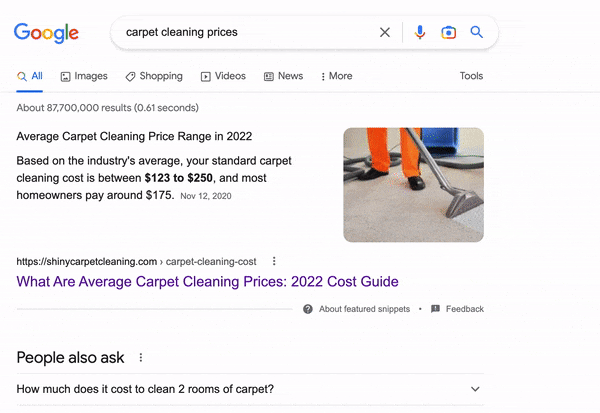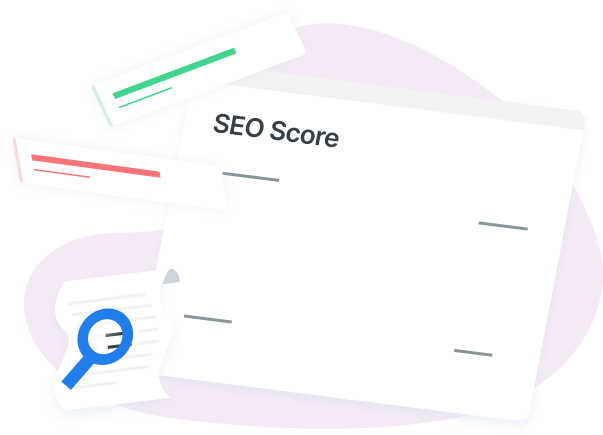-
 Published: Jan 23, 2023
Published: Jan 23, 2023
-
 7 min. read
7 min. read
-
 Maria Carpena
Maria Carpena Emerging Trends & Research Writer
Emerging Trends & Research Writer
- Maria is an experienced marketing professional in both B2C and B2B spaces. She’s earned certifications in inbound marketing, content marketing, Google Analytics, and PR. Her favorite topics include digital marketing, social media, and AI. When she’s not immersed in digital marketing and writing, she’s running, swimming, biking, or playing with her dogs.
SEO landing page definition: A search engine optimization (SEO) landing page is meant to attract organic search traffic relevant to one’s business and to drive conversions.
Think of SEO landing pages as high-value fish bait. In a sea full of prey (or web pages, in your case), your bait must stand out and be enticing among your audience that’s hunting for food (or content, in your case).
SEO landing pages lead new prospects to your site through organic search. These landing pages help drive conversions and increase sales. If you’re looking to improve your revenue through SEO-friendly landing pages, read further through this blog post, which will discuss the following:
You can also sign up for our free newsletter, Revenue Weekly, to get the latest SEO trends and tips delivered straight to your inbox.
Looking for an all-in-one SEO audit tool? You’ve found it.
SEO Checker provides data on key metrics to give you:
- Complete SEO score
- Content Grade
- Site Speed Analysis
- and more.

What is an SEO landing page?
An SEO landing page is designed to draw organic search traffic for keywords relevant to a business and its industry. Its ultimate goal? To drive conversions using relevant content tailored to answer a particular search query and intent.
SEO landing pages either convert visitors on-page or effectively pique their interest to encourage them to click other links where they can convert. These pages are usually part of an inbound marketing campaign aiming to increase site traffic from search relevant to your business. SEO landing pages may or may not be part of your website navigation.
Straightforward, clear, and equipped with a compelling call-to-action (CTA), SEO landing pages must provide a pleasant experience that will result in conversion. Take this example of a carpet cleaning landing page.

It ranks for the keyword “carpet cleaning prices.” This SEO landing page’s content offers a comprehensive guide to carpet cleaning costs. Toward the end of the post, it encourages readers to get a free quote by calling the company.
6 SEO landing page best practices
Optimizing your SEO landing pages can help increase awareness about your business as your target audience sees your pages rank on search engine results pages (SERPs). The right SEO strategies can drive qualified traffic to your landing pages, convert site visitors, and increase sales.
If you want to know how to optimize landing pages, here are six SEO landing page best practices:
- Use keyword research to guide your SEO landing pages’ content
- Help search engines understand your content structure
- Make your SEO landing pages mobile-friendly
- Mind your page load speed
- Make each landing page unique
- Monitor your SEO landing pages’ performance through analytics
Let’s go through each one!
1. Use keyword research to guide your SEO landing pages’ content
Keyword research is a critical first step to creating your SEO landing pages. Start by identifying long-tail keywords relevant to your business and products. Not sure what keywords your audience is using? Use keyword research tools like KeywordsFX.
Create content based on these keywords, ensuring you’re addressing the search intent behind the keywords. Google’s Helpful Content Update aims to deliver more relevant and valuable information to searchers, so the more helpful your landing page content is, the higher its chances of ranking. This algorithm update also means content written for humans will rank higher than content created for search engines.
Use the keywords in your written content, but avoid overusing them! Search engines can detect keyword stuffing, which won’t help you rank.
Instead, identify secondary keywords that you can use within your content. These keywords should add context to your SEO landing page and support your primary long-tail keyword.
For example, let’s say you’re an immigration lawyer practicing in Austin, Texas. Your SEO company for lawyers may suggest you optimize for your primary keyword “immigration lawyer in Austin” and secondary keywords like “immigration lawyer in Austin with free consultation.”
2. Help search engines understand your content structure
While your SEO landing pages are created for your prospects to consume, make sure you make them easy for web crawlers to read and analyze your landing pages’ structure. Doing so helps the bots understand what your landing pages are about and index them appropriately.
Make sure your landing pages have the following:
- Title tag: Keep your landing page’s title tag concise. Frontload your primary keyword in your title tag as much as possible.
- Meta description: Your meta description may appear in SERPs, thus helping convince a searcher to click your landing page. It is also a search ranking factor, so mention your primary keyword here.
- Headings: Use subheads within your content to break up text and make them easier to read. They also give search engines additional context about your landing page.
- Internal links: Internal links give search engines additional context about your SEO landing page. They also help spread link juice among your pages. Ensure your relevant internal links use anchor text related to the content.
- Alt tags: Add descriptive alt tags to your images so web crawlers can “read” your SEO landing pages’ images.
- Keyword-optimized URL: Use your SEO landing page’s URL to give searchers and search engines an idea about what your page is about.
- Earn good backlinks: Backlinks are links from other websites to yours. Earning a backlink from a reputable site proves that you’re a trustworthy business and will boost your page’s SEO.
3. Make your SEO landing pages mobile-friendly
With more than 52% of website traffic coming from mobile phones, it’s important to have mobile-friendly SEO landing pages. Make it easy for your visitors to convert by having a page that shows your CTA correctly, no matter the size of their device, thus enabling visitors to perform your desired action.
Mobile-friendly pages are also likely to rank on SERPs because Google uses mobile-first indexing. Not sure if your SEO landing pages are mobile-friendly? Run them through Google’s Mobile-Friendly Test tool.
4. Mind your page load speed
Page speed is an important SEO ranking factor that Google admits to using, so your SEO landing page must have an acceptable load speed. Stats say 83% of users expect websites to load in three seconds or less.
Here are a few tips to improve your page’s load speed by:
- Optimizing your images: Compress your page’s images to make the file size smaller without the quality of the photo. This is an efficient way to ensure that you can keep your current photos.
- Reducing HTTP requests: Your page takes time to download content, scripts, and other site components. This is an HTTP request. Minimize your page’s components, because the more components your page has, the longer it takes your page to load.
- Minimizing redirects: Redirects are a great fix to prevent site visitors from clicking on broken links. However, too many redirects can impact your page’s speed. Work on keeping your redirects to a minimum.
5. Make each landing page unique
SEO landing pages are typically part of a bigger marketing campaign, and some keywords may be related to one another. Despite the similarities, ensure every landing page is about 80% unique so that search engines won’t think they’re duplicate pages.
For example, let’s say you’re in the business of vacation rentals in different cities. Your offerings are almost alike except for their locations. Employ clever copywriting to differentiate one SEO landing page from another.
6. Monitor your SEO landing pages’ performance
Are your SEO landing pages ranking on SERPs and attracting clicks? Use Google Search Console to determine which ones rank for your target keywords.
Google Analytics, meanwhile, can tell you the number of unique users who landed on your page. If you want to know the number of conversions a landing page generates, you can also turn to Google Analytics.
MarketingCloudFX is another tool you can use to measure your SEO landing pages’ performance. It can monitor your pages’ overall search engine performance and current keyword rankings. With the power of artificial intelligence, MarketingCloudFX can also provide data-driven recommendations to improve your SEO landing page.
260%
increase in organic revenue
198%
increase in organic transactions
150%
increase in organic traffic
3872%
increase in sessions from SEO
Optimize your SEO landing pages with WebFX
SEO landing pages can help attract new prospects, drive conversions, and increase your revenue. Optimizing landing pages that convert takes a team of expert copywriters, designers, and developers.
If your team needs help with any aspect of creating SEO landing pages, let WebFX be your ally. We have a team of 500 subject matter experts who’d love to help you craft SEO landing pages that improve your bottom line.
Want to get started? Contact us online or call us at 888-601-5359 to speak with a strategist about our SEO services!
-
 Maria is an experienced marketing professional in both B2C and B2B spaces. She’s earned certifications in inbound marketing, content marketing, Google Analytics, and PR. Her favorite topics include digital marketing, social media, and AI. When she’s not immersed in digital marketing and writing, she’s running, swimming, biking, or playing with her dogs.
Maria is an experienced marketing professional in both B2C and B2B spaces. She’s earned certifications in inbound marketing, content marketing, Google Analytics, and PR. Her favorite topics include digital marketing, social media, and AI. When she’s not immersed in digital marketing and writing, she’s running, swimming, biking, or playing with her dogs. -

WebFX is a full-service marketing agency with 1,100+ client reviews and a 4.9-star rating on Clutch! Find out how our expert team and revenue-accelerating tech can drive results for you! Learn more
Try our free SEO Checker
Boost your site’s search performance with our free SEO Checker. Analyze your website for optimization tips on titles, headers, content, speed, and more. Get a free report now to enhance rankings on Google, Bing, Yahoo, and beyond!

Table of Contents
- What is an SEO Landing Page?
- 6 SEO Landing Page Best Practices
- 1. Use Keyword Research to Guide Your SEO Landing Pages’ Content
- 2. Help Search Engines Understand Your Content Structure
- 3. Make Your SEO Landing Pages Mobile-friendly
- 4. Mind Your Page Load Speed
- 5. Make Each Landing Page Unique
- 6. Monitor Your SEO Landing Pages’ Performance
- Optimize Your SEO Landing Pages with WebFX


How Is Your Website’s SEO?
Use our free tool to get your score calculated in under 60 seconds.
Try our free SEO Checker
Boost your site’s search performance with our free SEO Checker. Analyze your website for optimization tips on titles, headers, content, speed, and more. Get a free report now to enhance rankings on Google, Bing, Yahoo, and beyond!







